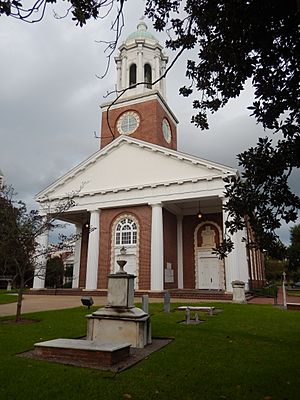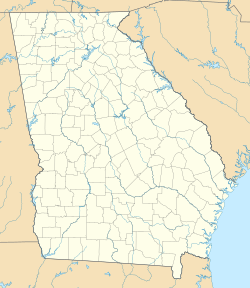Saint Paul's Church (Augusta, Georgia) facts for kids
Quick facts for kids Saint Paul's Church |
|
|---|---|

View of Saint Paul's Church from courtyard 2
|
|
| Religion | |
| Affiliation | Episcopal Church |
| District | Episcopal Diocese of Georgia |
| Ecclesiastical or organizational status | parish |
| Location | |
| Location | Augusta, Georgia, United States of America |
| Architecture | |
| Architectural style | Colonial |
|
Saint Paul's Church (Episcopal)
|
|
| Location | 6th and Reynolds Sts., Augusta, Georgia |
| Area | 2 acres (0.81 ha) |
| Built | 1751 |
| NRHP reference No. | 73000642 |
| Added to NRHP | April 11, 1973 |
| Website | |
| Saint Paul's Church | |
Saint Paul's Church is a very old church in downtown Augusta, Georgia. It is right next to Riverwalk Augusta. This church is part of the Episcopal Church. It uses the 1979 Book of Common Prayer for its services.
The church is located at the corner of 6th and Reynolds Streets. It has the oldest church group in Augusta. It started in 1750. The first church was built by the Church of England near Fort Augusta. Five different church buildings have stood on this spot over time. The church you see today was finished in 1920. It was designed by Henry Ten Eyck Wendell. It mixes styles like Federal, Georgian, and Greek Revival architecture. This building can hold up to 600 people.
Saint Paul's is a busy church today. It holds three Sunday services. These are at 8 a.m., 11 a.m., and 5:30 p.m. Each service includes the Lord's Supper, also called the Holy Eucharist. The 8 a.m. service is quiet with no music. The 11 a.m. service includes a choir. The 5:30 p.m. Celtic Communion is a calm service with music.
You can visit the main part of the church for quiet prayer. It is open Monday through Thursday from 9 a.m. to 3 p.m. On Fridays, it is open from 9 a.m. to noon. You can find a guestbook and history guides in the entrance area. For more details, you can visit the church's website.
The church also offers Christian learning classes for all ages. These are held every Sunday from 9:30 to 10:30 a.m. Childcare is available from 9 a.m. to 12:30 p.m. The 11 a.m. service is even broadcast on local radio. You can listen on WGAC 580 AM and WGAC 95.1 FM. You can also listen online.
Saint Paul's Church has a long history of helping the Augusta community. It works with other downtown churches. They provide food, medical help, housing, and money to people who need it. The church's Outreach Committee raises money for local charities. They also have a program called Manna Pantry. It gives healthy food to local families who struggle to get enough to eat.
The church has a special event space called the River Room. Many community events happen there. These include wedding parties, concerts, school proms, and meetings. Saint Paul's also helps athletes during the Augusta Ironman Triathlon. They offer a pasta dinner, a place to drop gear, and snacks. They also provide a quiet space for athletes to prepare.
Since 1988, Saint Paul's has hosted "Tuesday's Music Live." This is a big concert series held during lunch. It brings famous musicians from around the world to Augusta. From September to May, about 5,000 people attend these 13 free concerts. They feature classical, jazz, pop, and choir music. Businesses, foundations, and people's donations support these concerts.
Contents
A Look at Saint Paul's Church History
Saint Paul's Church was one of the first churches in the Georgia colony. It was the third church linked to the Church of England. The first two were in Savannah and Frederica.
There have been five Saint Paul's churches on the same corner. Church services have been held there since 1751. This makes Saint Paul's the "mother church" of Augusta.
The church began in 1749. Augusta residents asked for permission to build a church. They built a small wooden chapel next to Fort Augusta. This chapel was named Saint Paul's. It was named after the famous St. Paul's Cathedral in London.
At first, local people led the services. Then, Reverend Jonathan Copp arrived two years later. He brought a special bowl for baptisms. This bowl was a gift and can still be seen in the church today.
In 1758, the Georgia colony was divided into eight areas called parishes. The area where Augusta was located was named "The Parish Church and Burial Place of Saint Paul's."
The first church building was damaged during the French and Indian Wars. The second church was destroyed during the American Revolutionary War. A third church was built in 1786. The fourth church was designed in the colonial style. It burned down in the Great Augusta Fire of March 1916. This fire also destroyed many homes of church members.
The Episcopal Diocese of Georgia was started at Saint Paul's in 1823. During the Civil War, a big meeting of Episcopal Church leaders happened here. This was in November 1862. They created rules for their church in the Confederate States. They also chose Stephen Elliott as their main bishop.
Reverend John E. Hines was a leader at Saint Paul's from 1937 to 1941. He worked for fairness and equality. He later became a bishop and then the main leader of the Episcopal Church. He continued his work for social justice.
In 1968, another important meeting happened at Saint Paul's. Bishops from the Episcopal Church met with bishops from the Anglican Church of Canada. This was the first time these groups met formally. They talked about social problems and their relationships with other churches.
Saint Paul's Churchyard: A Historic Burial Ground
The churchyard at Saint Paul's is a historic cemetery. It holds the graves of important people. These include William Few, who signed the U.S. Constitution. Also buried here is George Mathews, a governor of Georgia.
Confederate General Leonidas Polk was buried here for a time. He was also an Episcopal Bishop. His body was later moved to New Orleans. A special plaque in the church remembers him. Joseph Wheeler, a Confederate general, was a member of Saint Paul's. Another Confederate General, James Longstreet, was confirmed at Saint Paul's in 1864.
The churchyard was also a burial place for enslaved people and free people of color. Their remains were moved in 1825 to a new cemetery. However, two black sextons, Abel Wright and Benjamin Whitehead, were buried in the churchyard. They served the church for many years. This showed the respect and affection the church had for them.
Old Records of Saint Paul's Church
Many old records about Saint Paul's Church are now online. You can find them through the Digital Library of Georgia (dlg.usg.edu). Just search for "St. Paul's Church, Augusta, Ga." These records are helpful for learning about history and family trees.
The records include church registers from 1820 to 1937. These books list baptisms, weddings, and other events. There are also minutes from church meetings from 1855 to 1923. These show details about staff pay, building costs, and special events. You can also find a history of the church from 1906. It was written by Reverend Chauncey Camp Williams. There are also other documents about important people and events in the church's past.
The Bells of Saint Paul's
The fourth Saint Paul's Church, built in 1820, had a bell tower. It held one bell made in England. This same company, Whitechapel Bell Foundry, also made Philadelphia's Liberty Bell and London's Big Ben.
Sadly, the 1820 bell was badly damaged in the 1916 fire. The pieces of the old bell were saved. They were later used in a new set of eleven bells for the fifth church. These new bells weighed over 12,000 pounds! They were made by the Meneely Bell Foundry in New York.
The new bells were officially dedicated in January 1924. They were first used for church services on June 1, 1924. They played a hymn called the Doxology. The largest bell has a special message. It says, "To the Glory of God and in Thanksgiving for the Restoration of this Church. Destroyed by Fire, 1916, Glory to God in the Highest." On the other side, it reads, "The Living to the Church I call, To the grave I summon all."
At first, people rang the bells using levers and ropes. In 1956, the bells became electric. Then, in 1985, the old parts that made the bells ring were replaced. New parts were made by a French company. The bells also got computer controls. This allowed them to be programmed to play at different times. Soon after, three more bells were added. This brought the total number of bells to fourteen. The computer system has been updated since then. Now, a touchscreen controls the bells.
Leaders of Saint Paul's Church
Rectors of Saint Paul's Church
- Rev. Jonathan Copp, 1751–1754
- Rev. Samuel Frink, 1765–1767
- Rev. Edward Ellington, 1767–1770
- Rev. James Seymour, 1771–1781
- Rev. Hugh Palmer, ?-1789
- Rev. Adam Boyd, 1790–1799
- Rev. Hugh Smith, 1818–1832
- Rev. Edward Eugene Ford, 1832–1862
- Rev. William H. Clarke, 1862–1878
- Rev. Chauncey Camp Williams, 1878–1906
- Rev. George Sherwood Whitney, 1906–1924
- Rev. Julius A. Schaad, 1924–1931
- Rev. John Armstrong Wright, 1931–1937
- Rev. John Elbridge Hines, 1937–1941
- Rev. E. Hamilton West, 1941–1948
- Rev. Charles F. Schilling, 1948–1962
- Rev. C. Edward Reeves, 1963–1974
- Rev. Roderic L. Murray, 1975–1980
- Rev. Peter Glyn Thomas, 1981–1989
- Rev. Donald A. Fishburne, 1990–2001
- Rev. Richard E. Sanders, 2002–2012
- Rev. George Daniels Muir, 2013–2021 (Priest-in-charge)
- Rev. Dr. Eric C. Biddy, 2021-present
Organists and Choirmasters of Saint Paul's Church
- James Hewitt, 1822-?
- Louisa V. Marshall, 1838–1859
- Ella Ernenputsch, 1859–1861
- E. Clarke Ilsley, 1861–1865
- M. E. Webber, 1866–1871
- John Weigand, 1871–1892
- W. F. Harris, 1892–1895
- H. I. Solomon, 1895–1899
- J. W. Crosley, 1899–1907
- Leo B. Pomeroy, 1901–1909
- Louis Sayre, 1911–1919
- George Johnson, 1919–1926
- George Craig, 1925–1944
- Bernard Carpenter, 1931–1953
- Sarah Alvater, 1955–1962
- Preston Rockholt, 1962–1964
- Everett Summerall, 1964–1982
- Keith Shafer, 1983–present
Notable People Buried Here
- Commodore Oliver Bowen, (1741–1800), a naval officer during the Revolutionary War.
- William Few, (1748–1828), represented Georgia at the Constitutional Convention. His body was moved here in 1973.
- Robert Forsyth, (1754–1794), the first federal law enforcement officer killed on duty. He was the father of Georgia governor John Forsyth.
- Ambrose Gordon, (1751–1804), a Revolutionary War soldier. He was the great-grandfather of Juliette Gordon Low, who founded the Girl Scouts.
- William Longstreet, (1760–1814), an inventor of steam-powered engines and cotton gins. He was the grandfather of Confederate General James Longstreet.
- George Mathews (1739–1812), a Governor of Georgia and U.S. Representative.
See also



